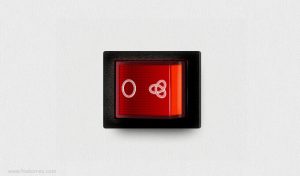Floquet Topological Insulators
Floquet Topological Insulators are topological phases resulting from strong light-matter interaction, or more generally, time-dependent perturbations (the name Floquet appears as Floquet theory is the prevalent theory for dealing with such effects). These topological phases can be achieved even in materials that natively lack topological states. Therefore, by using light one can achieve topological states similar to those in topological insulators.
Topological Insulators (TIs) are a recent family of exotic materials with a few intriguing properties. They are insulators in the bulk but their edges support propagating states bridging the bulk band-gap, much like the states emerging in the Quantum Hall effect discovered by Klaus von Klitzing in 1980 but in the case of TIs this happens without a magnetic field thanks to spin-orbit interaction. Recently, a new way of achieving properties akin to those found in quantum Hall systems started to gain attention: using a time-dependent potential to harness tunable topological properties.

Artist image of a graphene ribbon illuminated by a mid-infrared laser. Floquet chiral edge states [4] are shown to develop on top of the bulk bandgap [3]. Image © Luis E. F. Foa Torres.
Floquet Topological Insulators [1,2] can be made out of normal materials that develop properties akin to those in the quantum Hall regime, for example, upon illumination with a laser field. If we think for example on doing this on graphene, we would need first to introduce a bandgap, as graphene is a zero-gap semiconductor. A few years ago this was predicted to occur in [1] with light in the visible range. After analyzing the required intensities, we showed that for the effects to be sizeable, the laser needs to be in the mid-infrared range (photon energy of about 100 meV) [3].
In "Floquet chiral edge states in graphene" [4] we offered the first analytical solution for the topological states as well as numerics proving their chirality [A simple analysis for bilayer graphene can be found in [5]]. This study has been followed up in [6] with a few additional twists. The main message is that one can envision using light as a topological switch, the resulting states though, are not properly states of matter but rather states of a system out of equilibrium, hybrid electron-photon states.
More recently, we tackled the multiterminal conductance of such systems and found more surprises: Notably, the usual connection between counting the number/chirality of the edge states and the Hall conductance breaks down, not all the chiral edge states contribute equally to the Hall response as in the case of time-dependent systems [7]. The light-induced quantum Hall effect has been probed experimentally very recently in graphene [8].
As a side note, one of the simplest possible systems showing Floquet topological states and transitions between trivial and non-trivial band-structure is

Using light as a topological switch. Image: LEFFT.
the driven Su-Schrieffer-Heeger model analyzed in [9]. Besides the creation of Floquet topological states, the SSH model allows us to study the interplay between the native topology and the driving. The driven SSH model and our predictions for the so-called pi-modes has been verified experimentally in photonics systems later [10]. The driving a 3D topological insulator was studied in [11].
The field of Floquet Topological Insulators is just starting to flourish.
References
[1] T. Oka and H. Aoki, "Photovoltaic Hall effect in graphene", Phys. Rev. B 79, 081406(R) (2009). link [2] N. H. Lindner, Gil Refael, and V. Galitski, "Floquet topological insulator in semiconductor quantum wells", Nature Physics 7, 490–495 (2011). link
[3] H. L. Calvo, H. M. Pastawski, S. Roche, and L. E. F. Foa Torres, "Tuning laser-induced band gaps in graphene", Appl. Phys. Lett. 98, 232103 (2011).[pdf]
[4] P. M. Perez-Piskunow, G. Usaj, C. A. Balseiro, L. E. F. Foa Torres, "Floquet chiral edge states in graphene", Physical Review B, 89, 121401(R) (2014). link pdf
[5] E. Suárez Morell and L. E. F. Foa Torres, "Radiation effects on the electronic structure of bilayer graphene", Physical Review B 86, 125449 (2012). link [pdf]
[6] G. Usaj, P. M. Perez-Piskunow, L. E. F. Foa Torres, C. A. Balseiro, "Irradiated graphene as a tunable Floquet topological insulator", Physical Review B 90, 115423 (2014). [link]
[7] L. E. F. Foa Torres, P. M. Perez-Piskunow, C. A. Balseiro, and G. Usaj, "Multiterminal Conductance of a Floquet Topological Insulator", Physical Review Letters, 113, 266801 (2014). [pdf]
[8] J. McIver et al. Nature Physics 16, 38 (2020).
[9] V. Dal Lago, M. Atala, and L. E. F. Foa Torres, "Floquet topological transitions in a driven one-dimensional topological insulator", Physical Review A 92, 023624 (2015).
[10] Q. Cheng et al. Physical Review Letters 122, 173901 (2019). [publisher]
[11] H. L. Calvo et al., Physical Review B 91, 241404(R) (2015).
Commentaries/Notes/Other
The quest for new materials: Can any material become topological?
A related talk:
Using light as a topological switch, ICTP, Trieste, January 2019.